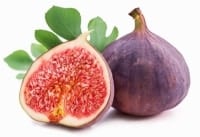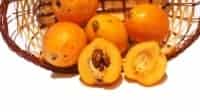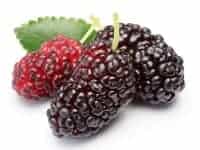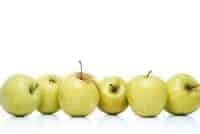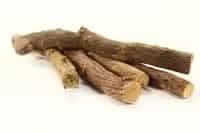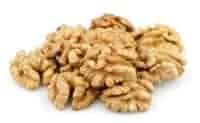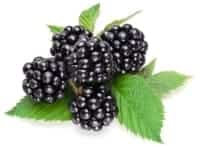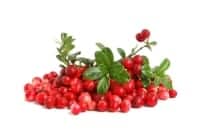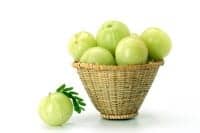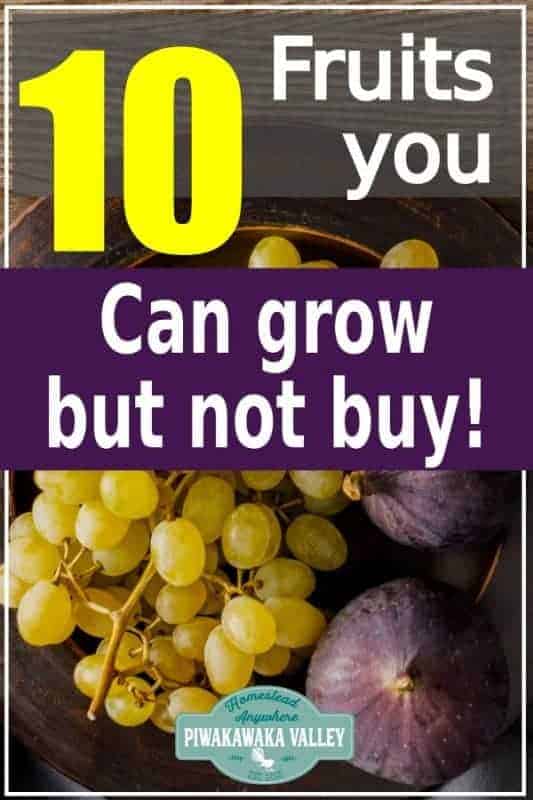This post was most recently updated on January 19th, 2021
One of the best things about growing your own food is the ability to grow and enjoy foods you either cannot get at the grocery store, or ones that are so expensive that you just don’t buy them.
Please read: This information is provided for educational purposes only and is not intended to treat, diagnose or prevent any disease. We encourage you to make your own health care decisions in partnership with a qualified health care professional.
This post contains affiliate links, this means at no extra cost to you, we make a commission from sales. Please read our Disclosure Statement
Growing your own food forest, even in quite a small urban garden, is a great way to include all these foods together for a super productive backyard.
Most of these plants do well in USDA zones 7 or better, but if you hunt around locally, you may find some that are suited best for your local climate.
RELATED POST: USDA zones, what are they and why do they matter?
10 Delicious Foods you can Grow at Home that you Can’t Buy in the Store
There are some foods, fruit in particular, that you can grow at home easily, that they don’t sell in the store because they:
- Are not economical to grow commercially
- Not possible to store long term (or even short term) reliably OR
- Not popular enough to warrant commercial investment
In some instances there are good reasons why foods are not commonly sold. Edible does not always equate to palatable!
Usually if a fruit says “good for jam making” it means it isn’t very nice raw or without sugar added!
Below are 10 hard, self sufficient plants that have delicious fruit that is worth growing in your yard or food forest.
RELATED POST: the 7 layers of a food forest explained
RELATED POST: 5 Steps to growing a food forest
For further reading, I really recommend all of these books. I own every one of them and they are amazing resources!
10 Great Backyard Fruit Plants
1 Figs
Figs are ripe from early Summer through to mid Autumn depending on the variety. There are many varieties that suit different climates, hunt around locally to find one that works where you are.
Technichically a fig is not a fruit so much as an inside out flower. I don’t know what went wrong there, but I am glad it did, they are delicious!
Figs are rarely sold ripe, as they have only a day or two between being under ripe and over ripe.
How to eat figs
Fresh figs are delicious with yogurt and a little drizzle of honey, or grilled lightly and served with blue cheese… stop it, I am drooling.
About growing figs in your backyard
Fig trees are deciduous and quite cold hardy, but the fruit will need plenty of sun to ripen well.
Some varieties in the right climate will fruit twice a year – one in Spring and once in late Autumn.
Trees can be grown in urban backyards and trimmed to keep them small, left to grow they will form a 2-3m thicket.
New fig trees are very easily propagated from cuttings, just take your prunings and stick them in the ground!
You can grab a fig tree here if you live in NZ try here for most of these plants.
RELATED: 20 foods you can grow from scraps
2 Loquats
Loquats are a juicy fruit a little bigger than a golf ball with a taste almost like a cross between an apricot and a lychee. Flavour does vary from variety to variety.
Loquats ripen in late Spring to early Summer and come in a range of varieties.
Loquats have a soft flesh and thin skin making them appropriate for commercial transport and sale, but PERFECT for the home orchard or food forest!
About growing loquats in your backyard
Loquats are easy to grow from seed and are generally very hardy. They have large glossy leaves and look quite tropical.
They are an evergreen that can withstand frosts once established and will tolerate wind, even salty wind, well.
You can buy loquat plants here
RELATED: the easiest vegetables to grow
3 Cape Gooseberry
These are a cute little fruit that grows within a paper lantern on an annual bush. They ripen from early Summer to early Autumn and in some climates will fruit all year round.
Cape gooseberries self sow happily from seed and it is very hardy, never having issues with pests or diseases.
In the same family as the tomato and the tomatillo, you can see the resemblance in the fruit.
They are little sweet bursts of flavour that my children just adore discovering and unwrapping the little paper lantern that surround the fruit.
You can use the fruit any way you please, they are amazing fresh, as well as baked or even dried like raisins.
Growing Cape Gooseberries
Each fruit is full of seeds, you only need to keep one fruit to make many, many bushes the next year.
The plant is a messy large bush with soft pale green leaves. It is very frost tender, and will die off with the coming of Winter in most places.
Once you have cape gooseberries they will continue to self seed and pop up each year.
To ensure a decent amount of fruit ripen before the cold hits, I usually start seeds inside in Winter, ready to transplant outside well after the last frost.
Be careful transitioning the plants from inside to outside, take it slowly or they will die of shock (ask me how I know…).
You can buy Cape Gooseberry plants here
RELATED: 100 plants for your food forest
4 Mulberries
A mulberry fruit looks a lot like a very long black raspberry, but it has a more gentle flavour.
Fruits ripen from late Spring to mid Summer and they come in black, white or red fruiting.
The black mulberry is the best for eating, the others make good jam..
Mulberry juice stains terribly, so don’t plant it near your washing line and don’t wear your Sunday best when picking the fruit!
Mulberry is also enjoyed by stock, the leaves and prunings are loved by goats, sheep, rabbits and cows.
Growing a Mulberry Tree
Mulberry trees are deciduous and not small. They do make a good large shelterbelt hedge if you have the space for such things.
They can get up to 10m in height, and live up to 200 or more years. The trees are robust and will handle most climates and winds.
Mulberries grow easily from cuttings, not quite as easily as figs, but not far from it!
You can buy mulberry trees here
RELATED: top 10 medicinal herbs that are easy to grow
5 Heritage Apples
Normal apples are easy to come by in the supermarket, and home gardeners often have to fight with codling moth, so why would you choose to grow them at home?
Supermarket apples are bred for sweetness and their ability to store well. They are sprayed a lot to keep all the marks and bugs away, and they are NOTHING like homegrown apples.
There are different varieties for eating fresh (called dessert apples), cooking with and for making cider (not nice to eat).
Cooking apples are perfect to make apple sauce and pies with, there are some that cook down like fluffy mashed potato and the taste is out of this world.
Growing Heritage Apples
There are SO many varieties of apple as each seed will grow differently from the parent plant.
Look around at local nurseries, or you can try your hand at grafting your own heritage apples like I did.
RELATED POST: Grafting fruit trees
6 Licorice
Ok, so I get that it isn’t really a fruit, but it is sweet and it is delicious!
Licorice is a hardy spreading perennial shrub that will grow to about a meter (3ft) high over Summer and die back over Winter.
After a few years it will be strong enough that you can dig up the roots and harvest them.
Dry the roots for tea, or wash the dirt off and chew on some fresh.
Growing Licorice
As it is a spreading plant, it is best where it can spread out. It happily grows amongst pasture or in the orchard.
Licorice is a nitrogen fixer as it is actually a legume.
It will tolerate almost every growing condition except extreme shade. You can grow it easily from seed or fresh root cuttings.
7 Walnuts
OK, again, not a fruit, but hear me out. Fresh walnuts are NOTHING like the wizened sour things you buy in the store. Fresh walnuts are sweet and divine.
Walnuts are reading in Autumn and there are quite the range of varieties.
Walnuts contain about 60% oil, that start to go rancid at room temperature. To store your nuts well, once they are dry, spend a night cracking them all, and freeze the kernels to keep them sweet and fresh.
Growing Walnut Trees
The trees can be expensive to buy, but if you plant a walnut in it’s shell on its side, it will eventually grow, and grow BIG.
Luckily the trees are self fertile, so one will be enough. We grew up with a massive walnut tree in our urban backyard. It was a fantastic swing tree, as well as an afternoon snack.
Walnut trees are fairly hardy, though they don’t like salt or very windy conditions.
In humid areas both blight and codling moth can be an issue.
RELATED: How to propagate elderberries for free
8 Brambles – Blackberries
There is nothing like the hard fought for taste of a fresh, warm, juicy bramble berry. Thorny blackberries grow wild in patches, and have become quite a pest, so it is no longer legal to propagate them.
You can buy thornless blackberries, and while they are much more pleasant to pick from, they are not quite as robust and rambling as the thorny varieties.
Growing Blackberries
Blackberries don’t like things growing around their stems. But give them plenty of manure and something to ramble over and they are pretty low maintenance.
9 Cherry Guava
There are quite a range of Guava available, the feijoa is even a type of guava. These cherry guava are much more hardy and cold tolerant of most other guava.
They grow to an attractive chest height bush and come in both red and yellow varieties.
The fruit comes ripe in late autumn and you can cook them and then squash them through a sieve to make a flavoursome paste that is divine spread on the top of cake or a meringue roulade.
The fruits also make great pies and cakes.
Growing Cherry Guava
They are hardy little plants that make great hedges and windbreaks for areas in the the garden. They tolerate wind and light frosts well.
10 Gooseberries
These are different to the cape gooseberry!
These fruit in mid Summer and while some people (my mother!) like eating the tart green fruits, they are much nice when left to ripen to a light red.
The fruit are delicious fresh, or can be made into pies or cakes, or dare I say it, jams and jellies.
Growing Gooseberries
Gooseberries grow easily from either pinning down a stalk for a few months and letting it take root, or dividing off of a current bush.
The prefer a sunny spot and tolerate drought fairly well.
They do have some spines, but they are nowhere near as prickly as a wild blackberry, and there are some thornless varieties available.
Feed them a little compost each year and they will supply you will yummy fruit!
You can buy plants here
If you would like help getting the most out of your garden, I would love to help you, find out more here
RELATED: Free Gardening Resources
If you like tips on frugal living, self sufficiency and consuming less, sign up to our newsletter below, I would LOVE to have you
For further reading, I also recommend all of these books. I own every one of them and they are amazing resources!






